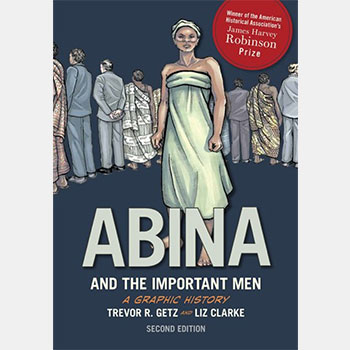We use cookies on this site to enhance your experience.
By selecting “Accept” and continuing to use this website, you consent to the use of cookies.

May 27, 2015
By: Parker Beemer
Historiography has been dominated by researchers gathering information on a particular topic, critically analyzing the material and then presenting their arguments in the form of an article or book. In the past few decades, however, this approach to presenting history has undergone significant evolution, with new methods becoming noticeably more frequent. One of these limited but nonetheless powerful new forms of historical scholarship is the ‘graphic history,’ based on the popular graphic novel format, which combines dialogue and illustrations to recount historical events.
An excellent example of this new genre is Abina and the Important Men by Trevor R. Getz and Liz Clarke. Set in Africa’s Gold Coast (present day Ghana) in 1876, the book follows the story of the wrongfully enslaved young woman Abina Mansah and her battle with the court system to convict her master, Quamina Eddoo. The term ‘Important Men’ refers to Eddo as well as other slave owners and lawyers, but it is not meant to imply that they are superior to Abina. Quite the contrary, as I explain below, Getz and Clarke sympathize with Abina and they want to share the story of her courage – even though she ultimately loses the court battle (she does, however, remains in the capital as a free woman).
By providing a graphic history followed by a second section that presents the actual historical court transcript, readers are given a unique reading experience. The authors’ skills shine particularly in the graphic portion of the text, which provides readers with a visual representation of the individuals, discussion, and questioning that would have taken place in the courtroom. The value of this is twofold: readers can more easily understand the complex court transcript, while simultaneously being entertained. The second part of the text solidifies this understanding further. By providing the actual document, readers can reference and compare the graphic history to the historical framework which it is based on, furthering their understanding of Abina’s story while increasing their ability to understand more complex primary documents like court transcripts.
The books’ strength as a resource also stems from its alternative look at slavery and the slave trade. During the 18th century, roughly 74,000 slaves were exported from the Gold Coast each year. A standard historical analysis of this phenomenon would provide the key facts, but it might fail to develop a deep connection with most readers because the slaves would be reduced to mere statistics. By focusing on a particular individual, Abina and the Important Men develops a personal connection between the reader and Abina. Furthermore, by focusing on a lowly slave girl whose voice was not heard in court, Getz and Clarke provide a grassroots perspective rarely seen in the historiography. Rather than hearing about the important individuals responsible for the slave trade and slavery, readers are introduced to a character who had to suffer through it. In the grand scope of history, Abina Mansah is nothing more than a microscopic watermark. But perhaps that is why her perspective is so valuable. By allowing access into the life of an average person from that time period, readers are able to gain a more thorough understanding of what slavery was like and how it affected society in the Gold Coast. It is also quite likely that the name of the text is meant as an ironic gesture. Perhaps the frequent encounters with ‘important men’ throughout the text and the authors’ choice to portray them as relatively insignificant and bland individuals in comparison with Abina is a poke at other historiographies that view history from only the ‘great men’ approach.
In conclusion, Abina and the Important Men is an immensely valuable resource. Its ability to present an accurate and enjoyable narrative, to provide an alternative look at slavery and its nature in West Africa, and to take a new approach to historiography makes this graphic history very successful. Despite a few minor problems stemming from a slight lack of historical context and bias, on the whole Getz and Clarke’s book makes an important contribution to historiography. As historical methods continue to advance, so will the methods of writing about it. One can only hope that others will take the example set out by Abina and the Important Men and continue to expand on the way in which humans understand their histories.